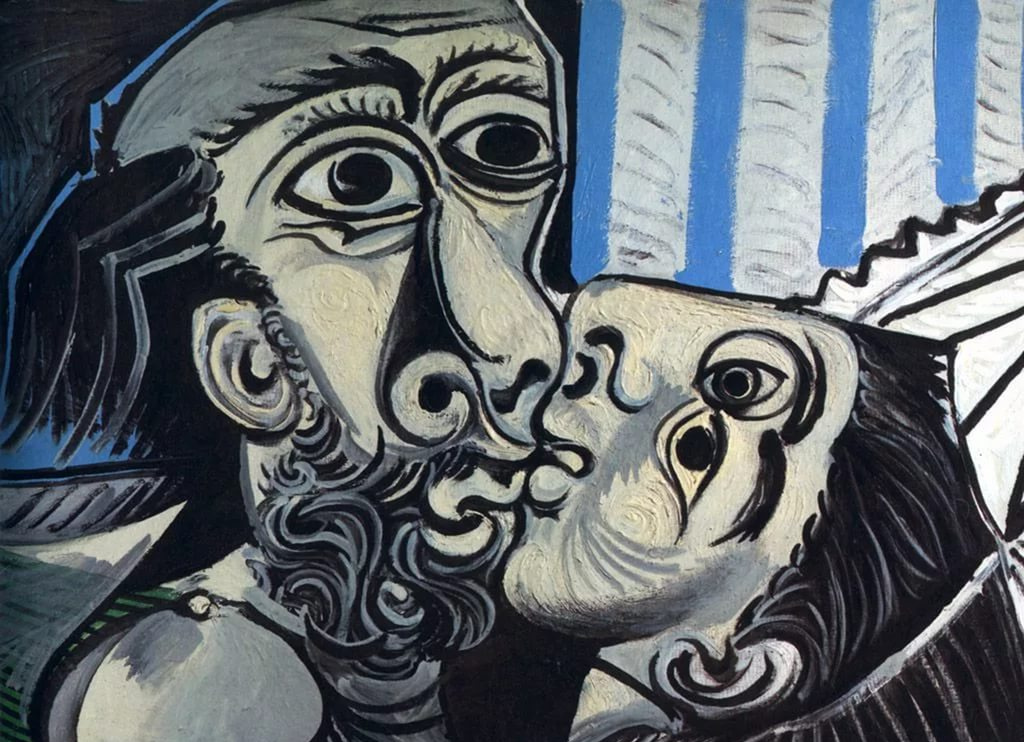log in
Enter site
Login to use Arthive functionality to the maximum
The kiss
Pablo Picasso • Painting, 1969, 97×130 cm
Description of the artwork «The kiss»
In the last works of Picasso, the theme of sexuality and sensual love is especially bright. He obsessively painted countless naked bodies and couples holding themselves in their arms. The personality of the woman most often featured on these canvases is beyond doubt: this is Jacqueline Roque, Picasso’s second wife and last love. In later years, the artist led an extremely solitary life, and his wife almost maniacally protected him from “external intrusions” and actually became his only muse.
As for the male subjects, in his later canvases, Picasso mostly depicted himself, indulging himself through romanticizing his own image. The hero of his last portraits is a certain Musketeer (1, 2, 3) a slightly unkempt middle-aged man with greying hair in a baroque suit and wide-brimmed hat. Among other things, we can see this subject in the Fatherhood painting, and his features are easily seen in the face of the figure from The Kiss canvas, which was painted in 1969.
Picasso depicted a couple that merged in a kiss against an almost bare background, focusing only on their faces. He did not hesitate to distort the lovers’ faces in order to bring them as close to each other as possible, to display the deep fusion of two kissing people. To emphasize this unity, Picasso endowed the couple with similar facial features (for example, the same nose shape). The balding man with a long grey beard, dressed in a recognizable vest, is Picasso himself, without a doubt. His eyes are wide open, as if he had just experienced some kind of revelation. The eyes of his beloved are also open, and the viewer can see both of them, despite the fact that the woman is painted in profile. Against her background, the man’s face seems disproportionately large, but this surprisingly creates a feeling of affection and care emanating from him. During this period, the all-consuming sexual fever disappeared from Picasso’s paintings depicting couples in love, only tenderness and serenity remained, which filled his years of life with Jacqueline.
Written by Yevgheniia Sidelnikova
As for the male subjects, in his later canvases, Picasso mostly depicted himself, indulging himself through romanticizing his own image. The hero of his last portraits is a certain Musketeer (1, 2, 3) a slightly unkempt middle-aged man with greying hair in a baroque suit and wide-brimmed hat. Among other things, we can see this subject in the Fatherhood painting, and his features are easily seen in the face of the figure from The Kiss canvas, which was painted in 1969.
Picasso depicted a couple that merged in a kiss against an almost bare background, focusing only on their faces. He did not hesitate to distort the lovers’ faces in order to bring them as close to each other as possible, to display the deep fusion of two kissing people. To emphasize this unity, Picasso endowed the couple with similar facial features (for example, the same nose shape). The balding man with a long grey beard, dressed in a recognizable vest, is Picasso himself, without a doubt. His eyes are wide open, as if he had just experienced some kind of revelation. The eyes of his beloved are also open, and the viewer can see both of them, despite the fact that the woman is painted in profile. Against her background, the man’s face seems disproportionately large, but this surprisingly creates a feeling of affection and care emanating from him. During this period, the all-consuming sexual fever disappeared from Picasso’s paintings depicting couples in love, only tenderness and serenity remained, which filled his years of life with Jacqueline.
Written by Yevgheniia Sidelnikova


